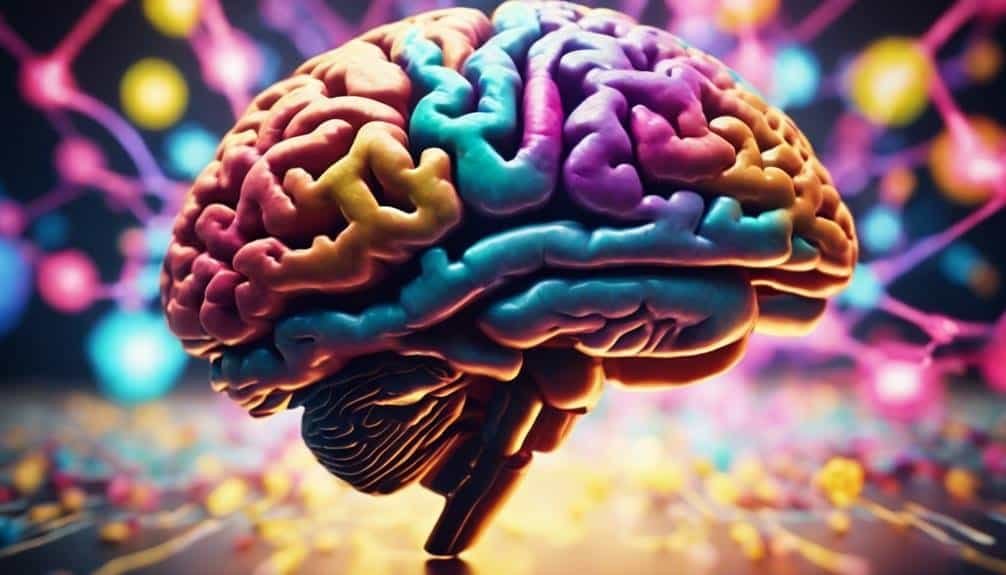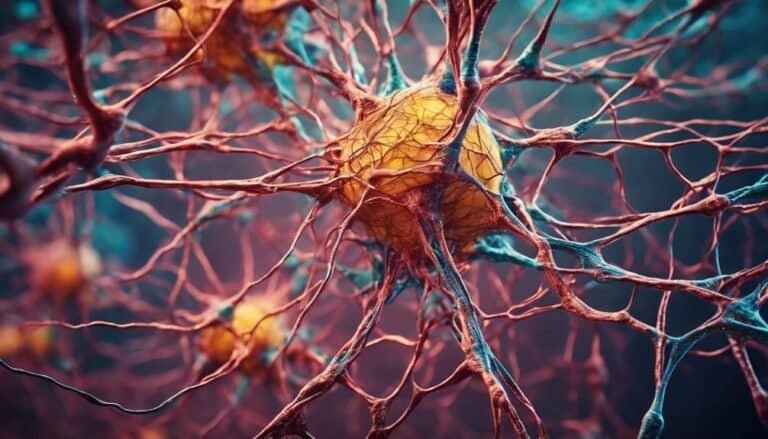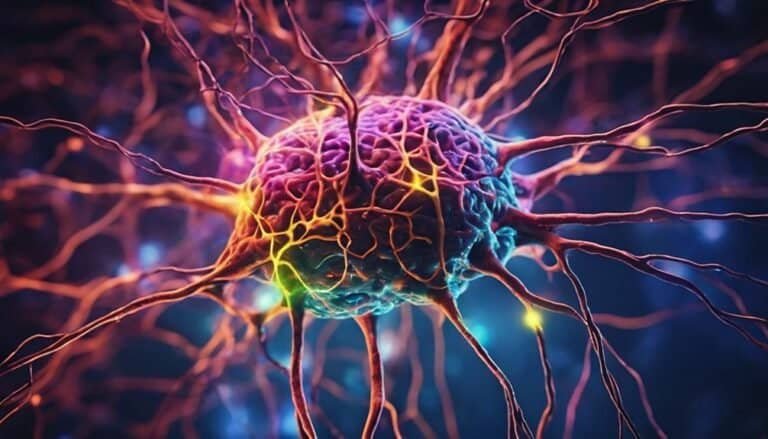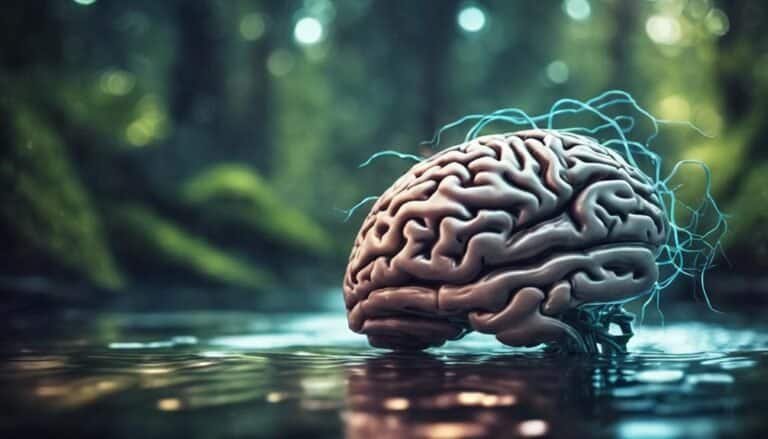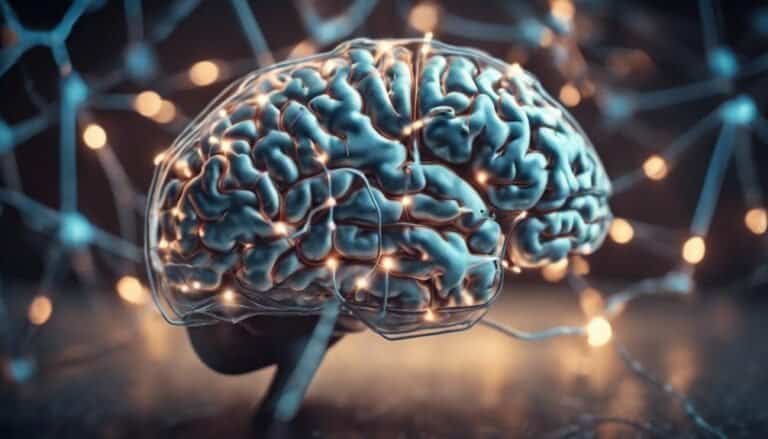Brain Chemistry of Joy and How to Harness It
Imagine your brain as a delicate orchestra, each neurotransmitter playing a vital role in orchestrating your experiences of joy. But how can you conduct this symphony towards a harmonious balance of happiness?
Understanding the intricate dance of dopamine, serotonin, endorphins, oxytocin, and even cortisol offers a roadmap to tapping into the brain chemistry of joy. Harnessing these neurotransmitters effectively can lead to improved mood, reduced stress, and an overall sense of well-being.
Key Takeaways
- Joyful activities trigger neurotransmitter release, influencing happiness.
- Lifestyle choices impact serotonin levels, crucial for well-being.
- Oxytocin promotes social connection and empathy, enhancing joy.
- Strategies like meditation, gratitude, and exercise boost neurotransmitters for increased happiness.
The Science Behind Joy
Understanding the neurochemical processes underlying joy is crucial in unraveling the complex mechanisms of human happiness. Joyful activities trigger a cascade of events in the brain, leading to the release of specific neurotransmitters and hormones that contribute to the feeling of joy. When you engage in activities that bring you joy, such as spending time with loved ones or pursuing a hobby, your brain chemistry is altered in profound ways.
Brain chemistry plays a significant role in shaping our emotional experiences. Dopamine, often referred to as the 'feel-good' neurotransmitter, is released in response to pleasurable activities. This surge in dopamine levels reinforces the behavior that led to the joy, making you more likely to repeat the activity in the future. Additionally, endorphins, another group of neurotransmitters, are released during joyful activities, acting as natural painkillers and mood elevators.
Neurotransmitters and Happiness
When you experience joy, it's your brain's dopamine that plays a key role in signaling pleasure.
Serotonin, another neurotransmitter, is crucial for maintaining a sense of well-being.
Endorphins, the body's natural painkillers, contribute to feelings of euphoria.
Dopamine and Pleasure
Dopamine, a neurotransmitter in the brain, plays a crucial role in experiencing pleasure and happiness. When something good happens, such as receiving a reward or enjoying a delicious meal, dopamine release occurs in specific regions of your brain associated with pleasure pathways.
This release of dopamine reinforces behaviors that lead to positive outcomes, making you more likely to seek out similar experiences in the future. Pleasure pathways, primarily involving the ventral tegmental area and nucleus accumbens, are key players in this process.
Understanding how dopamine influences your feelings of pleasure can help you appreciate the importance of positive experiences in shaping your overall sense of happiness.
Serotonin and Well-Being
Serotonin, a neurotransmitter crucial for regulating mood and emotions, plays a vital role in promoting overall well-being and happiness in the brain. Maintaining optimal serotonin levels is essential for various well-being benefits, including mood stability, emotional regulation, and overall contentment. Serotonin is involved in controlling anxiety, depression, and stress responses, highlighting its significance in mental health.
| Serotonin Levels | Well-Being Benefits |
|---|---|
| Regulate mood | Enhance emotional regulation |
| Reduce anxiety | Promote feelings of contentment |
| Manage depression | Improve overall mental health |
| Control stress responses | Support emotional stability |
Optimizing serotonin levels through healthy lifestyle choices, such as regular exercise, a balanced diet, and sufficient sleep, can positively impact one's well-being and contribute to a happier state of mind.
Endorphins and Euphoria
Endorphins, known as the body's natural painkillers, are neurotransmitters that contribute to feelings of euphoria and play a significant role in the experience of happiness.
When you engage in physical exercise, such as running or resistance training, your body releases endorphins. This endorphin release is responsible for the 'runner's high' often experienced during and after intense workouts.
The benefits of exercise extend beyond physical fitness; the euphoric effects of endorphins can enhance your mood and overall sense of well-being.
Additionally, music therapy has been shown to trigger the release of endorphins in the brain, leading to feelings of pleasure and elation.
Dopamine: The Pleasure Molecule
In the neural pathways of the brain, a key neurotransmitter known for its role in pleasure and reward is dopamine. Dopamine release is crucial in experiencing pleasure sensations. This neurotransmitter is involved in various brain functions, including motivation, reinforcement, and movement. Below is a table outlining some key aspects of dopamine:
| Aspect | Description | Importance |
|---|---|---|
| Dopamine Production | Synthesized in the brain, primarily in the substantia nigra and ventral tegmental area. | Essential for regulating mood and motivation. |
| Dopamine Receptors | Found in different regions of the brain, such as the nucleus accumbens and prefrontal cortex. | Play a role in pleasure, reward, and decision-making. |
| Dopamine Dysfunction | Imbalance linked to various disorders like Parkinson's disease, schizophrenia, and addiction. | Understanding crucial for developing treatments. |
Understanding the role of dopamine in pleasure and reward mechanisms can provide insights into how to enhance joy and motivation in daily life.
Serotonin: The Mood Regulator
Having explored the role of dopamine in pleasure and reward pathways, it's crucial to now examine the function of serotonin as a key regulator of mood in the brain. Serotonin, a neurotransmitter primarily found in the gastrointestinal tract and central nervous system, plays a pivotal role in mood regulation. Serotonin levels in the brain are tightly controlled, influencing various aspects of emotional well-being and mental health.
The intricate mechanism of serotonin involves its release and reuptake by neurons, impacting mood stability. Low serotonin levels have been linked to conditions such as depression and anxiety disorders, highlighting the significance of this neurotransmitter in maintaining emotional balance. Serotonin receptors, particularly the 5-HT1A subtype, play a critical role in mediating its effects on mood regulation.
Furthermore, serotonin doesn't act alone; it interacts with other neurotransmitters and hormones to modulate mood states. Understanding the delicate balance of serotonin levels and its impact on mood regulation is essential for addressing mental health concerns and promoting emotional wellness.
Endorphins: The Feel-Good Hormones
With their role in modulating pain perception and promoting feelings of pleasure, endorphins are crucial neurotransmitters that play a significant role in the brain's neurochemical landscape. Endorphins, often referred to as the body's natural painkillers, are produced in response to stress and pain, acting as a way for the body to cope with discomfort. Two common ways to boost endorphin levels are through exercise and laughter.
Endorphins and Their Effects:
| Endorphin Release Trigger | Effects on the Body |
|---|---|
| Exercise | Promotes feelings of euphoria and reduces pain sensation. |
| Laughter | Enhances mood, decreases stress, and may alleviate pain. |
Engaging in physical activity like running, swimming, or dancing can lead to what is commonly known as a "runner's high," a feeling of well-being and reduced anxiety attributed to endorphin release. Similarly, laughter has been shown to increase endorphin levels, contributing to the sense of joy and relaxation experienced after a good laugh. By understanding how endorphins function, you can harness their power to enhance your overall sense of well-being.
Oxytocin: The Love Hormone
Oxytocin, known as the love hormone, plays a crucial role in social bonding and emotional regulation within the brain's neurochemical network. This neuropeptide is synthesized in the hypothalamus and released into the bloodstream via the pituitary gland. Oxytocin receptors are abundant in brain regions associated with social behavior, such as the amygdala and the prefrontal cortex.
When oxytocin is released, it promotes bonding benefits by enhancing trust, empathy, and social connection. In social interactions, this hormone fosters feelings of closeness and attachment between individuals. Oxytocin is particularly involved in maternal bonding, facilitating the mother-infant relationship and promoting caregiving behaviors.
Moreover, oxytocin isn't only limited to maternal bonds; it extends to various social relationships, including romantic partnerships and friendships. The presence of oxytocin in the brain contributes to the regulation of emotions and the establishment of social bonds critical for overall well-being. Embracing and nurturing these social connections can lead to increased oxytocin levels, reinforcing positive emotional experiences and strengthening interpersonal relationships.
Cortisol and Stress Response
The brain's response to stress involves the release of cortisol, a hormone crucial for regulating the body's physiological reactions in challenging situations. Cortisol is produced in the adrenal glands and plays a significant role in the body's stress response system. When faced with a stressful situation, cortisol levels rise, helping to increase blood sugar, regulate metabolism, reduce inflammation, and assist in memory formulation. However, prolonged exposure to high levels of cortisol can have detrimental effects on the body, such as impaired cognitive function, weakened immune system, and increased risk of conditions like anxiety and depression.
Effective cortisol regulation is essential for proper stress management. Techniques such as mindfulness, exercise, adequate sleep, and social support can help in maintaining healthy cortisol levels. By incorporating stress-reducing practices into your daily routine, you can better manage your body's cortisol response, leading to improved overall well-being and a more balanced stress reaction. Remember, maintaining a healthy cortisol balance is key to mitigating the negative effects of chronic stress on both the body and mind.
Strategies for Boosting Joy
Boosting joy can be achieved through implementing specific strategies that target the brain's chemistry and emotional well-being. Two effective methods for enhancing joy are mindful meditation and gratitude journaling.
Mindful meditation involves focusing your attention on the present moment without judgment. This practice helps regulate emotions and reduce stress by increasing activity in the prefrontal cortex, the area of the brain associated with positive emotions. By training your mind to stay present and aware, you can cultivate a sense of inner peace and happiness.
Gratitude journaling entails regularly writing down things you're thankful for. This simple act can shift your focus from negative to positive experiences, leading to an improved mood and overall well-being. Research suggests that expressing gratitude activates the brain regions associated with dopamine production, the neurotransmitter responsible for pleasure and reward.
Conclusion
In conclusion, harnessing the brain chemistry of joy is like conducting a symphony of neurotransmitters in perfect harmony.
By understanding the roles of dopamine, serotonin, endorphins, oxytocin, and cortisol, you can optimize your mental well-being and overall happiness.
Implementing strategies such as exercise, mindfulness, social connections, and gratitude can help you orchestrate a beautiful composition of joy in your brain.
Keep experimenting and fine-tuning your conductor skills for a blissful existence.

